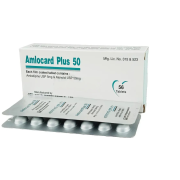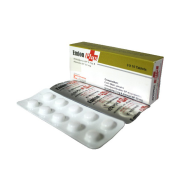Amlotol Plus Tablet
Amlodipine Besilate + Atenolol
Indications
This is indicated in-
- Patients with essential hypertension
- Patients with angina pectoris & hypertension as co-existing diseases
- ln post Ml patients
- ln patients with refractory angina pectoris where nitrate therapy has failed.
Pharmacology
This is a fixed-dose combination of Amlodipine and Atenolol. Amlodipine is a dihydropyridine calcium antagonist that inhibits the transmembrane influx of calcium ions into vascular smooth muscle and cardiac muscle; it has a greater effect on vascular smooth muscle than on cardiac muscle. Amlodipine is a peripheral vasodilator that acts directly on vascular smooth muscle to cause a reduction in peripheral vascular resistance and reduction in blood pressure. Amlodipine reduces tone, decreases coronary vasoreactivity and lowers cardiac demand by reducing afterload.
Atenolol is a cardioselective beta-blocker. The cardio-selectivity is dose-related. Atenolol causes a reduction in blood pressure by lowering cardiac output, decreasing the plasma renin activity and sympathetic outflow from CNS. Atenolol also causes a reduction in myocardial oxygen demand by virtue of its negative inotropic and negative chronotropic effects.
Dosage & Administration
The recommended dosage is Amlodipine and Atenolol 5/25 mg tablet once daily. If necessary, the dosage may be increased to 5/25 mg two tablets daily or as advised by the physicians. The dosage however should be individualized.
* চিকিৎসকের পরামর্শ মোতাবেক ঔষধ সেবন করুন‘
Interaction
Disopyramide: Atenolol reduces the clearance of disopyramide by 20%. Additive negative inotropic effects on the heart may be produced.
Ampicillin: at doses of 1 gm and above may reduce Atenolol levels.
Oral antidiabetics and insulin: Beta-blockers may decrease tissue sensitivity to insulin and inhibit insulin secretion e.g. in response to oral antidiabetics. Atenolol has less potential for these actions.
Contraindications
Hypersensitivity to either component, sinus bradycardia, second and higher degrees of heart block, cardiogenic shock, hypotension, congestive heart failure, poor left ventricular function.
Side Effects
The combination of Amlodipine and Atenolol is well tolerated. Overall side-effects include
fatigue, headache, edema, nausea, drowsiness, anxiety and depression.
Pregnancy & Lactation
The combination should be used during pregnancy only if the expected benefit outweighs the potential fetal risk. The combination should not be used by nursing mothers. If its use is considered necessary, breast-feeding should be stopped.
Precautions & Warnings
Bronchospasm: The combination should be used with caution in patients with airway obstruction.
Renal impairment: The combination can be used in patients with renal impairment. However, caution may be necessary if the creatinine clearance is less than 30 ml/min because of possible reduction in the excretion of unchanged Atenolol.
Hepatic impairment: Caution may be necessary in the use of the combination in patients with severe liver damage because of prolongation of the elimination half-life of Amlodipine.
Drug withdrawal: Since coronary heart disease may exist without being recognized, patients should be warned against stopping the drug suddenly. Any discontinuation should be gradual and under observation.
Overdose Effects
Though not documented, hypotension and less frequently congestive cardiac failure may occur in cases of overdosage. Unabsorbed drugs may be removed by gastric lavage or administration of activated charcoal. Symptomatic treatment is suggested.
Therapeutic Class
Combined antihypertensive preparations
Storage Conditions
Keep below 30°C temperature, away from light & moisture. Keep out of the reach of children.



